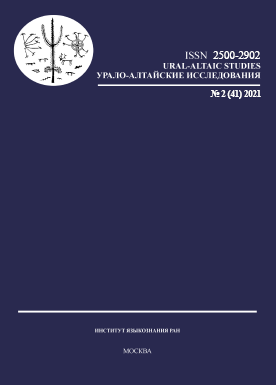СТОЯЛА ЛИ ФОНЕТИЧЕСКАЯ РЕАЛЬНОСТЬ ЗА УДАРЕНИЕМ В ОБДОРСКОМ СЛОВНИКЕ Г. Ф. МИЛЛЕРА?
WAS THERE ANY PHONETIC REALITY BEHIND THE POSITION OF STRESS IN G. F. MÜLLER’S OBDORSK WORDLIST?
Author(s): Julia V. NormanskajaSubject(s): Theoretical Linguistics, Phonetics / Phonology, Lexis, Finno-Ugrian studies
Published by: Институт языкознания Российской академии наук
Keywords: experimental phonetics; dialects of Nenets; field data; archive data;
Summary/Abstract: I.B. Itkin and S.I. Pereverzeva note in their article “Some clarifications to the interpretation f the data of the Obdorsk Nenets dictionary (reply to the article of P. I. Li “The graphic analysis of the first syllable vowel system in Nenets dictionaries from A. M. Sjögren’s archive” // Ural-Altaic Studies. 2021, 1 (40). P. 47—60) that the position of stress in some words in the Obdorsk dialect found in the materials from A.M. Sjögren’s archive, which were probably copied from the lists collected by G. F. Müller, does not coincide with the data on the Yamal dialect. Hence, the following question is bound to arise: is there any prosodic reality behind the position of stress in the Obdorsk wordlist from A.M. Sjögren’s archive? In this connection, the data from the dictionary of the Gydan dialect of the Tundra dialect of the Nenets language (http://lingvodoc.ispras.ru/dictionary/704/16/perspective/704/17/view), created by M. K. Amelina, seemed quite promising. The search for the etymological cognates of the words from the Obdorsk wordlist under consideration yielded 28 lexemes. Based on auditory perception, in 26 of them, the position of stress coincides with the Obdorsk words. These lexemes were analyzed using Praat, an experimental software package for phonetic analysis. The findings show that Obdorsk words which are stressed on the first syllable have a significantly higher intensity of the first syllable vowel in modern Gydan (5–18 dB higher than that of the second syllable vowel) whereas Obdorsk words with stress on the second syllable have a longer second syllable vowel in modern Gydan (by 0.04–0.11 seconds longer than the first syllable vowel) with differences in intensity between the first and the second syllables being no more than 3 dB, that is, imperceptible to the human ear. These results suggest that a certain phonetic reality corresponded to the position of stress in the Obdorsk wordlist, and it was not assigned by G.F. Müller accidentally.
Journal: Урало-алтайские исследования
- Issue Year: 2021
- Issue No: 02 (41)
- Page Range: 155-158
- Page Count: 4
- Language: Russian

